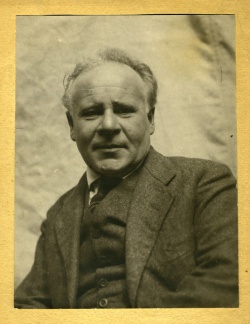Difference between revisions of "Arthur Segal"
| Line 29: | Line 29: | ||
* http://weimarart.blogspot.com/2010/06/arthur-segal.html | * http://weimarart.blogspot.com/2010/06/arthur-segal.html | ||
* http://sdrc.lib.uiowa.edu/dada/dadas/segal.htm | * http://sdrc.lib.uiowa.edu/dada/dadas/segal.htm | ||
| + | * http://exhibitions.europeana.eu/exhibits/show/dada-to-surrealism-en/jhm-zurich/arthur-segal | ||
* [http://en.wikipedia.org/wiki/Arthur_Segal Segal at Wikipedia] | * [http://en.wikipedia.org/wiki/Arthur_Segal Segal at Wikipedia] | ||
__NOTOC__ | __NOTOC__ | ||
Revision as of 08:21, 28 March 2016
 Arthur Segal in 1921. | |
| Born |
July 23, 1875 Iaşi, Romania |
|---|---|
| Died |
June 23, 1944 (aged 68) London, United Kingdom |
Born 1875 to Jewish parents in Iaşi, Romania. In 1892 Segal studied at the Academy of Art in Berlin, taking master classes with Eugen Bracht. Two years later he continued his studies at the Académie Julien in Paris, attending Ludwig Schmid-Reutte and Friedrich Fehr’s painting school in Munich one year later, after which he took up studies with Carl von Marr at the Academy of Art in Munich, where he was active as a freelancer from 1899 before moving to Berlin in 1904. He took part in the 1909 and 1913 exhibitions of the Berliner Secession. His first woodcuts were published in Herwarth Walden’s Der Sturm in 1911, followed a year later by an exhibition in Walden’s eponymous art gallery.
In 1914 he emigrated to Ascona and became acquainted with Hans Arp, Alexei von Jawlensky, Hugo Ball, and Leonhard Frank. In 1916 he had an exhibition at the Cabaret Voltaire of the Zurich Dadaists, returning in 1920 to Berlin where he opened his own painting school, with Nikolaus Braun and Lou Albert-Lasard among his students. He was a member of the Novembergruppe [November Group], being on its board of directors for some time and repeatedly participating in the group’s exhibitions from 1921 to 1931. His Berlin studio was the place of regular meetings of Adolf Behne, Raoul Hausmann, Hannah Höch, Kurt Schwitters, and George Grosz. Together with Otto Dix, George Grosz, and Käthe Kollwitz among others he was active in the trade unions’ campaign "For an eight-hour-day". In 1925, together with Nikolaus Braun, he published the treatise Lichtprobleme der Bildenden Kunst [On the Problem of Light in the Fine Arts].
In 1925 he declined an offer to teach at the New Bauhaus in Dessau. Because of his Jewish background he was prevented from exhibiting his work in Germany, thus in 1933 he moved to Palma, Mallorca and three years later to London where he opened a painting school with his daughter Marianne. In 1944 he died of heart failure during a bombing raid of the German Luftwaffe.
Works
- Cosmogenie, c1925, c207 pp. Poetry manuscript.
Correspondence
- Letters from Arthur Segal to Nikolaus Braun and Anneliese Ratkowski, 1920-29.
- Letters from Arthur Segal to Nikolaus Braun and Anneliese Ratkowski, 1930-35.
- Letters from Arthur Segal to Nikolaus Braun and Anneliese Ratkowski, 1936-39.